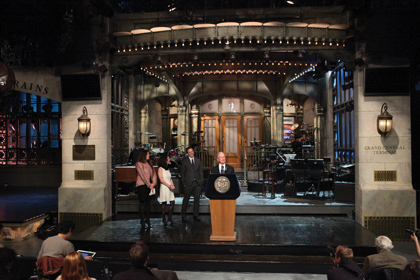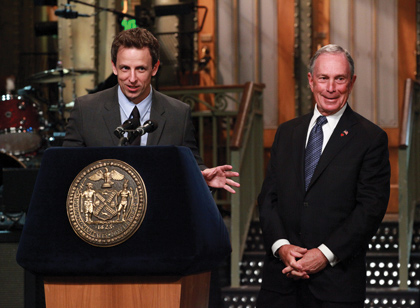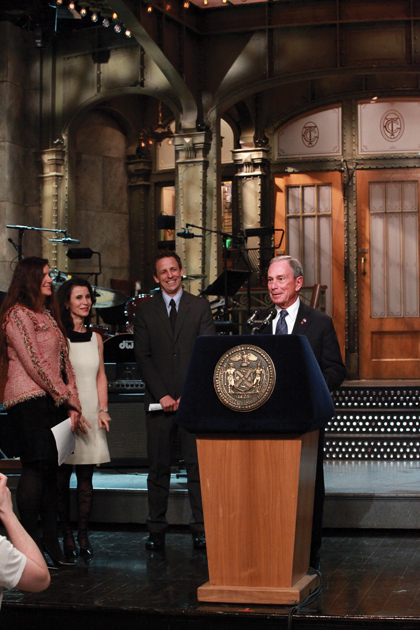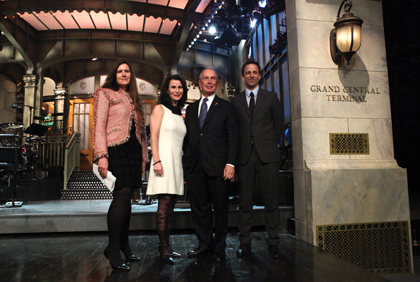
MAYOR BLOOMBERG ANNOUNCES THAT FILM AND TELEVISION INDUSTRY HAS SPENT $60 BILLION IN NEW YORK CITY OVER PAST DECADE
TELEVISION PRODUCTION IS NOW AT AN ALL TIME HIGH
While National Media Sector Lost 40,000 Jobs Over the Past Decade, New York City Gained 40,000
New York City’s Film and Television Industry Generated $7.1 Billion in 2011 and Has Employed 130,000 New Yorkers since 2004
Mayor Joined “Saturday Night Live” Cast Members to Announce Results of Study
Mayor Michael R. Bloomberg and Media & Entertainment Commissioner Katherine Oliver announced the results of an economic study conducted by the Boston Consulting Group that details the growth and economic impact of New York City’s media and entertainment industries. Over the last ten years, filmed entertainment in New York City has seen remarkable growth and is currently the strongest in its history generating direct spending of $7.1 billion in 2011, an increase of over $2 billion dollars annually since 2002.

Photos: Spencer T Tucker
Film and television production now employs 130,000 people, an increase of 30,000 jobs since 2004. Mayor Bloomberg made the announcement at 30 Rockefeller Center where he was joined by Kate Sayre from the Boston Consulting Group and members of the “Saturday Night Live” cast.
“This report confirms what I’ve been seeing on sets and sound stages around the city – the film and television industry in New York City has never been bigger,” said Mayor Bloomberg. “In fact, our entire media landscape, from digital media to advertising, has shown strong growth throughout the economic downturn. The strength of these industries is a key reason we’ve weathered the recession better than the rest of the country and it is confirmation that our strategy to diversify our economy is working.”
“Mayor Bloomberg has made diversifying New York’s economy by supporting industries like film and television, fashion, technology and tourism a centerpiece of his economic development strategy. The report we’re releasing confirms that the Mayor’s strategy is paying off,” Deputy Mayor for Economic Development Robert K. Steel said. “The film and television industry now employs 130,000 people and helps support hundreds of related businesses in sectors like construction and food service.”
“You only have to turn on the TV or go online to see New York City’s presence in media and entertainment,” said Commissioner Oliver. “We’ve seen a surge in film and television production in recent years and an increase to the number of home grown start ups. It’s important to remember that all of this activity translates directly to jobs for New Yorkers.”

“It’s truly impressive how the City’s media and entertainment industries have grown and gained share at a time when media jobs nationwide have been disappearing,” said Kate Sayre, a partner in BCG’s New York office. “By developing effective programs that make New York even more attractive to media companies, Katherine Oliver and her team have significantly strengthened the City’s position as a premier location for film and TV as well as new media. We at BCG have been honored to support their efforts for almost a decade.”
“As Mayor Bloomberg and Commissioner Oliver frequently note, New York City is the creative capital of the world,” said Chief Digital Officer Rachel Sterne. “It’s no surprise that as a result of the City’s strong media heritage, content creation plays a key role in New York’s digital ecosystem, and it is thrilling to see the community’s growth on display in this report.”
Additionally, the Partnership for New York City’s investment fund has established a $2 million revolving loan facility to assist special effects and post production companies that are expanding their operations in New York City. The first loan will be made to Look Effects, whose New York offices are located in Brooklyn, for $200,000.
“The BCG study confirms that the Bloomberg Administration has successfully reestablished New York City as the creative hub of the film, television and digital media industries,” said Kathryn Wylde, President & CEO of the Partnership for New York City. “We are pleased to make funds available to incentivize companies to conduct their post production work in the five boroughs.”
BCG’s reports aims to analyze the development and growth of the City’s media by examining different subsectors and identifying the main trends that have shaped and will continue to shape local media and digital media sectors.
Filmed Entertainment
According to the report, despite a nationwide industry decline, 30,000 jobs were created in New York City’s filmed entertainment industry since 2004, and the sector’s money spent has grown by 70 percent since 2002. The industry today accounts for $7.1 billion in money spent and employs 130,000 people. This growth was been accompanied by private infrastructure investment, expanding studio and post production capacity.
Television and film studio space has nearly doubled, and the post production industry has also grown significantly. TV productions grew by nearly 82 percent, driving most of the sector growth with an increase in dramas, reality and talk shows. TV production also supports an increaseof 14,000 jobs.
Digital Media
Since 2002, the local digital media sector has surged in the City to now account for revenue of over $8 billion and full time employment of 25,000 people. The City’s share of national media and entertainment venture capital investment has gone from 10 percent in 2002 to over 26 percent in 2011, funneling $500 million to local media start ups in 2011 and making Silicon Alley the second largest market for digital media investments nationally after the Silicon Valley.
Hundreds of local digital start ups have been founded in the last few years with a significant proportion in media and entertainment. In recent years, large companies have opened and increased their New York presence.
Google opened its engineering office in 2007, Twitter opened an office in 2011, and Facebook announced the opening of its first engineering office outside the West Coast in 2012. New York City’s unique combination of financial, advertising, creative, technical and cultural resources positions the City as major center for digital media.

Advertising and Publishing
New York City’s advertising industry has shown strong growth both in terms of jobs and revenues over the past ten years. Local advertising jobs increased 18 percent since 2002, while nationwide jobs have decreased significantly. Many traditional agencies acquired digital capabilities and are now leaders in producing multi-media campaigns.
Publishing, faced with increased competition from the internet advertising, social media and proliferation of content distribution platforms, has experienced a nationwide decline with lower advertising and newsstand revenues. However, in New York City, publishing companies have shed jobs at a lower rate than nationwide. Many publishers have been able to offset the decrease in newsstand revenues with growth in digital publications for tablet devices and e-readers. Overall, publishing continues to be an important source of jobs and revenues to the City.
Overall Media in NYC
New York City has also maintained leadership in the broader media sector which supports over 275,000 direct full time equivalent jobs and generates more than $80 billion in direct revenues annually. From 2002 to 2011, while nationwide media employment shrunk and the industry rapidly evolved, New York was able to drive significant job and revenue growth continuing to attract new companies in all sectors and increased its importance as the major media hub. It has also grown its share of nationwide media employment from 9.4 percent to 10.8 percent. Since 2002, New York has created 40,000 media sector jobs while the U.S. has shed 40,000 jobs.
Looking to the Future
BCG’s report suggests that while NYC has made great strides in developing critical media and entertainment industries, there is more that can be done to guarantee its position as the media hub of the future by serving as a preferred destination for digital media companies, media start ups and high quality talent. The City’s media leaders interviewed as part of the report highlighted the importance of increasing sector promotion, community engagement, talent development and overall infrastructure as ways to strengthen the industry.
In efforts to proactively promote these industries, the City has launched several initiatives to address these areas, including the Big Apps competitions, the NYC Entrepreneurial Fund, the support of various City incubators, the establishment of Technion-Cornell Innovation Institute at Roosevelt Island, and the creation of NYC Digital and the City’s first Chief Digital Officer. The City’s Office of Film, Theatre and Broadcasting also maintains its role to promote and attract film and television to the five boroughs. Boston Consulting Group’s report focused on film and television production:
• TV shows, films, commercials, cable networks, radio stations,
Other traditional media companies:
• Advertising, media buying, public relations, marketing,
Publishing:
• Books, newspapers, magazines, news companies, and
• Digital companies - both established and start ups.
The report does not include live theatre, concerts, sports, cable companies, or wireless companies. The complete report can be found at www.NYC.gov.
